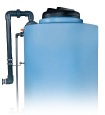Ferrics, alums and polymers are commonly used to treat water and wastewater. There are several reasons why these substances require specialized storage: Separation, settling and coagulation are major issues with these chemicals – and those conditions can be compounded by temperature variations. Settling and separation issues can lead to difficulty in pumping the chemicals.
Topics:
Chemicals
Whether you're storing dangerous chemicals or common food-grade materials, reliability of structural integrity is one of the most important factors to consider when purchasing a tank.
Topics:
Value Added
Sulfuric acid can be a tricky chemical to store. Used in a wide variety of industrial applications, sulfuric acid is heavy, can create toxic or flammable gas, and can burn the skin. A smart storage solution for sulfuric acid should start with a well-thought-out tank design — not just the tank material but the entire storage system and all its components. Thinking through the entire sulfuric acid tank system design up front will help you protect your employees, the environment, and your investment. Read on for our recommendations on the right material, configuration, and standards for safe sulfuric acid storage.
Topics:
Chemicals,
Chemical Storage
The traditional choice for storing the materials in making beer and wine is stainless steel, copper, or oak casks. But breweries and wineries are beginning to see the benefits of using polyethylene storage tanks. What’s causing beer and wine industries to make the shift? Cross-linked polyethylene (XLPE) tanks are an ideal solution for breweries and wineries that would rather invest in scaling their business than sinking money into unnecessarily expensive equipment.
Universal ball dome fittings, or UBD fittings, are a type of tank fitting that has a moveable ball inside to allow angular adjustments. UBD fittings can only be installed on the dome of the chemical storage tank, because they aren’t considered leak-tight. The dome fitting has a compression nut that locks down the ball after you install the flange or bulkhead, allowing connections at angles up to 24 degrees. The self-aligning UBD fittings can be installed on the dome of a Poly Processing storage tank to give you more options for fitting placement. UBD fittings are an excellent choice for our double-wall SAFE-Tanks®, vertical tanks, or IMFO® Tanks. Let’s take a look at the uses for these types of fittings and their advantages.
Topics:
Fittings and Accessories
Poly Processing’s stronger-than-ever chemical tank pad, PolyBase, is engineered to handle more pressure and larger tanks. We have two types of PolyBase available: rotationally molded PolyBase systems for our IMFO® Tanks, and an innovative structural Polyurethane foam-based IMFO PolyBase option.
Topics:
Fittings and Accessories
Poly Processing tanks are used for water and wastewater treatment applications, but are also found in dozens of industries nationwide. We’re able to work with a wide variety of businesses and organizations that use chemicals to produce goods and products. This is the first in a series of articles over the next several months that will feature a selection of the markets we serve. (View the full list of the markets we serve.)
Topics:
Applications,
Tank Design and Materials,
Chemical Storage
When it comes to a full discharge tank, cone-bottom tanks get the job done—except when they don’t. The fact is, cone-bottom tanks fall short on several fronts. Cleaning cone-bottom polyethylene tanks can be challenging. They require additional vertical space and safety precautions. And the tanks themselves cost a pretty penny — especially when you have to include a stand and basket to support the cone-bottom tank. Prices can skyrocket in today's market with the costs of metal and special coatings. Lead times for welded steel products can be extremely long as well.
Topics:
Tank Design and Materials
Poly Processing is committed to ensuring that our polyethylene chemical storage systems are NSF/ANSI/CAN 61 certified. In our previous article on NSF, we looked at NSF/ANSI/CAN 61 and what it means to be certified. There can be some confusion about whether tanks or tank systems are certified to NSF/ANSI/CAN 61 and which certification is valid for which tank.
Topics:
Certifications and Standards
Municipal projects require detailed specifications for anything purchased as a capital expense. At Poly Processing Company, we’ve teamed up with national engineering firms and municipalities to develop industry leading pre-written engineering specifications for our three most popular polyethylene chemical tanks: the SAFE-Tank®, the vertical tank with IMFO® and the upright vertical storage tank.
Topics:
Certifications and Standards,
Value Added,
Chemical Storage



